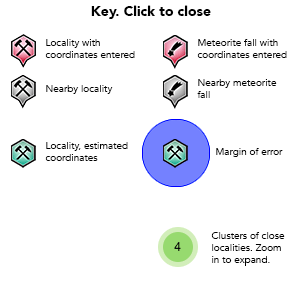Ilmars prospect, Alice Downs Station, Halls Creek Shire, Western Australia, Australia

| Latitude & Longitude (WGS84): | 18° 3' 58'' South , 127° 51' 46'' East |
|---|---|
| Latitude & Longitude (decimal): | -18.06606,127.86270 |
| GeoHash: | G#: qufcjx4v8 |
| Locality type: | Prospect |
| Köppen climate type: | BSh : Hot semi-arid (steppe) climate |
Located in the northern Ilmars Range, about 30 kilometres north north-east of Halls Creek, and 5 kilometres east of the Great Northern Highway. Described as 200 yards from the road to Saunders Creek, on the crest of a sharp ridge 50 feet high. Much explored, with mineralisation found, but nothing yet economic. Cu-Pb-Zn prospect. First explored by Peko Mines NL in 1963.
The deposit occurs is schists, variably quartz-sericite, quartz-chlorite, carbonate rich, and graphite schists, with interbedded tuff, limestone, calcareous mudstone, shale and chert. Oxidation reaches 18 to 30 metres below the surface.
Mineralisation occurs for 1800 metres long, with lower grades another 3000 metres further south. Pyrite and/or pyrrhotite dominates, with sphalerite, and minor galena, chalcopyrite, trace arsenopyrite and tetrahedrite-tennantite. The sulphides range from fine grain disseminations to semi massive concentrations. Most of the mineralisation is in quartz and feldspathic schist.
The prospect was discovered with exposed surface gossans in 1963. These are orange or red/brown soft porous limonitic rocks, commonly showing boxwork, with malachite, cuprite, hydrozincite, minor azurite, chalcocite, covellite, native copper, and rare smithsonite and cerussite. The gossan was found in two sections, of thinly bedded dolomitic shale separated by a barren zone. The gossans strike north for 850 feet, average 60 feet wide, dips 65 degrees west. They are split by a leached zone 15 feet wide of unmineralised tremolite. The secondary copper minerals are abundant as bands, patches, and small lenses.
Mineral List
25 valid minerals.
Rock Types Recorded
Select Rock List Type
Alphabetical List Tree DiagramRegional Geology
This geological map and associated information on rock units at or nearby to the coordinates given for this locality is based on relatively small scale geological maps provided by various national Geological Surveys. This does not necessarily represent the complete geology at this locality but it gives a background for the region in which it is found.
Click on geological units on the map for more information. Click here to view full-screen map on Macrostrat.org
| Paleoproterozoic 1600 - 2500 Ma ID: 3186269 | Paleoproterozoic sedimentary rocks Age: Proterozoic (1600 - 2500 Ma) Comments: Arunta Block Lithology: Sedimentary rocks Reference: Chorlton, L.B. Generalized geology of the world: bedrock domains and major faults in GIS format: a small-scale world geology map with an extended geological attribute database. doi: 10.4095/223767. Geological Survey of Canada, Open File 5529. [154] |
| Orosirian 1800 - 2050 Ma ID: 773047 | Biscay Formation Age: Orosirian (1800 - 2050 Ma) Stratigraphic Name: Biscay Formation Description: Low to medium grade metamorphosed basaltic volcanics, volcaniclastics, dolerites, pelites and carbonates; carbonate and chert lenses, and local sandstone interbeds Comments: igneous mafic volcanic; igneous volcanic; synthesis of multiple published descriptions Lithology: Igneous mafic volcanic; igneous volcanic Reference: Raymond, O.L., Liu, S., Gallagher, R., Zhang, W., Highet, L.M. Surface Geology of Australia 1:1 million scale dataset 2012 edition. Commonwealth of Australia (Geoscience Australia). [5] |
Data and map coding provided by Macrostrat.org, used under Creative Commons Attribution 4.0 License



